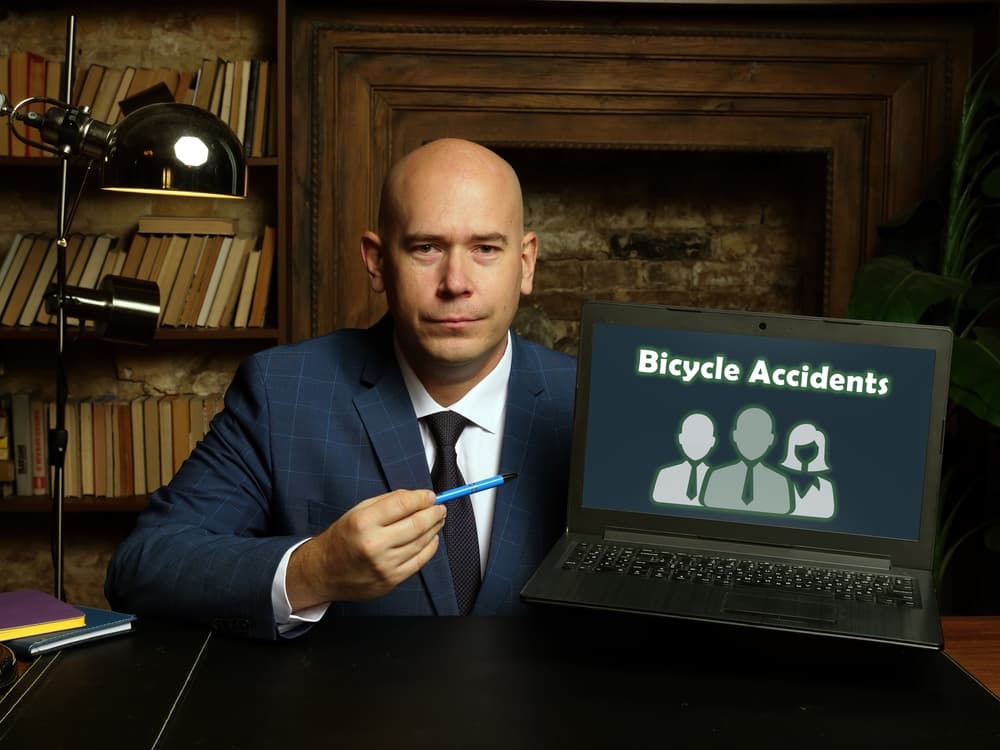Bicyclists are at risk of suffering severe injuries in an accident because of their limited protection while on the road. With the possible exception of their bicycle helmet, a bicycle rider is directly exposed to their environment (including the ground), increasing their chances of suffering significant injuries in a collision. These injuries are common if a cyclist is involved in a forceful rear-end accident or head-on collision that dislodges them from their bicycle.
Many bicycle accidents happen when other drivers are negligent, such as speeding or failing to observe the road. If you or a person you care about recently sustained injuries in a bicycle crash, you need to retain an experienced attorney who can handle your personal injury claim for you.
An experienced bicycle accident lawyer can take the burden off your shoulders so you can seek treatment for your injuries and focus on getting better. During that time, your attorney can focus on gathering the necessary documents to prove your case, filing a personal injury claim with the insurance company, and negotiating with claims adjusters. Your attorney may also file a lawsuit in your case – especially if the statute of limitations is about to run.
Throughout the case, your attorney will aggressively fight for your legal rights and interests and represent you during various litigation proceedings. By aggressively advocating on your behalf, your attorney will work to maximize the total compensation you receive for the injuries you suffered in your bicycle accident.
Schedule a Free Initial Consultation Today!
How do Bicycle Accidents Usually Occur?
Bicycle accidents can result from a variety of factors, often involving a combination of human error and environmental conditions. Understanding the common causes and types of bicycle accidents is essential for both cyclists and motorists to enhance roadway safety.

One of the most common causes of bicycle accidents is collisions with motor vehicles. These collisions frequently occur when motorists fail to see cyclists or misjudge their speed, leading to side-impact, rear-end, or intersection collisions. Inattentive or distracted driving, along with intoxicated driving, significantly contribute to these accidents.
Another common type of bicycle accident is a dooring accident. Opening a car door without first checking for approaching cyclists poses a significant risk. When a driver or passenger opens their car door into the path of an oncoming cyclist, the cyclist may fall to the ground and sustain severe injuries, including bone fractures and traumatic head injuries.
Intersection conflicts are another common cause of bicycle accidents. Busy traffic intersections can be extremely hazardous for cyclists – especially when motorists fail to yield the right-of-way to cyclists or fail to notice them. Right-hook collisions, where a turning vehicle strikes a cyclist traveling in the same direction, are especially common at intersections.
Bicycle accidents may also result from unsafe passing maneuvers by other motorists. For example, a motorist may fail to use a proper turn signal when switching lanes or pass a cyclist too closely and clip the cyclist, leading to an accident. Adequate passing distance and awareness are also crucial for preventing these occurrences.
In addition, uneven road surfaces, potholes, debris, and inadequate signage may cause or contribute to bicycle accidents. Cyclists may lose control or collide with obstacles, leading to falls or crashes. In many instances, municipalities – including cities, counties, and townships – are negligent for failing to properly maintain roadways in their jurisdictions.
Bicycle accidents can also result from distracted driving. Distracted driving occurs when another driver fails to watch the road attentively. With the many electronic devices people have today, including GPS navigation systems, smartwatches, and cell phones, it is easy for a driver to become distracted. In addition to looking at electronic devices, ea driver may become distracted if they roughhouse with passengers in their vehicle, listen to loud music, apply make-up while driving, or eat and drink while on the road. These activities may cause a driver to turn their head, take their eyes off the road, and miss seeing an approaching bicyclist.
Poor visibility, especially during low-light conditions or inclement weather, also increases the risk of bicycle accidents. Similarly, aggressive driving by motorists – including road rage – can lead to dangerous situations for bicyclists. Road rage may take many forms, but it often involves speeding, tailgating, and sudden lane changes.
If you or someone you love suffered injuries in a bicycle accident that resulted from another person or entity’s negligence, a skilled bicycle accident attorney near you can explore your potential legal options and file a claim with the appropriate insurance company.
What are the Most Common Injuries that Bicyclists May Suffer in an Accident?
Bicyclists are vulnerable road users, and when they become involved in accidents, they can sustain a wide range of injuries. Their vulnerability stems from the lack of protective barriers between their bodies and the ground. The most common injuries that bicyclists suffer in accidents can have varying degrees of severity, impacting physical well-being and often requiring extensive medical treatment. Some of the most common injuries that bicyclists suffer in accidents include:
- Head injuries: Head injuries, including concussions and traumatic brain injuries (TBIs), are among the most serious and potentially life-threatening injuries that bicyclists may sustain in accidents. Even with helmets, the force of impact in a bicycle accident may cause debilitating head injuries, leading to long-term cognitive impairments – or, in severe cases, fatalities.
- Road rash: When a bicyclist makes contact with the road surface during a fall or collision, abrasions and skin injuries, known as road rash, are common. Road rash can range from minor scrapes to more severe lacerations, potentially causing long-term scarring.
- Crush injuries: In more severe bicycle accidents involving collisions with larger vehicles or fixed objects, bicyclists may suffer crush injuries. These injuries occur when their body becomes compressed between their bicycle and another object, leading to organ damage, bone fractures, or the need for amputations.
- Facial injuries: Bicyclists are at risk of suffering serious facial injuries, including fractures to the jaw, cheekbones, or nose. Impact with the ground, a vehicle, or other objects can result in facial trauma, sometimes requiring one or more surgeries to correct.
- Joint injuries: The effects of a bicycle accident can result in joint injuries, such as dislocations or injuries to the knees and shoulders. These injuries may ultimately require surgical intervention and prolonged rehabilitation to treat them.
- Fractures and broken bones: Bicyclists often suffer fractures and broken bones in accidents, particularly in the arms, wrists, and collarbones. The instinct to use one’s arms to break a fall can result in direct impact injuries to these bodily areas.
- Spinal cord and paralysis injuries: Although less common, accidents can lead to spinal cord and paralysis injuries for bicyclists. The force of impact or an awkward fall may result in damage to the spine, potentially causing paralysis or long-term neurological issues.
- Soft tissue injuries: Sprains, strains, and other soft tissue injuries can occur due to the impact of a bicycle collision or a sudden fall. Ligaments, tendons, and muscles may become stretched or torn, leading to pain, swelling, and reduced mobility for the cyclist.
- Internal injuries: The force of impact in a bicycle crash may cause various internal injuries, including damage to organs such as the spleen, liver, or kidneys.
- Emotional and psychological trauma: Besides physical injuries, bicyclists may experience psychological trauma following an accident. Post-traumatic stress disorder (PTSD), anxiety, and depression can seriously affect the mental well-being of individuals who have suffered injuries in traumatic bicycle accidents.
Recovery from bicycle accident injuries often involves ongoing medical treatment, rehabilitation, physical therapy, and occupational therapy.
Preventive measures, including sturdy helmets and reflective gear, can significantly reduce the risk of these common injuries and lessen the chance of injury in a severe accident. However, cyclists still deserve compensation for injuries due to drivers, even if they were not wearing a helmet or other gear.
How do I Legally Prove a Bicycle Accident Claim or Lawsuit?
Legally proving a bicycle accident claim involves establishing key elements to demonstrate liability and quantify damages. Whether pursuing a personal injury claim or seeking compensation from the at-fault party’s insurance company, a well-documented and persuasive case is essential.

First, if possible, gathering evidence at the bicycle accident scene is important. That evidence may include all of the following:
- Photographs of the accident scene, including the positions of the vehicles involved, any road hazards, traffic signals, and weather conditions
- Witness contact information from individuals who observed the accident firsthand and who can corroborate your version of events
- A police report that offers an objective, unbiased record of the accident and may include the officer's assessment of fault (including whether or not they issued the at-fault driver a citation, and if so, what that citation was for).
It is also important that bicycle accident victims retain all evidence related to their accident, including damaged clothing, the bicycle, and any equipment. These items may later be physical evidence if the case proceeds to a civil jury trial. Injured cyclists should also keep records of all related expenses, including medical bills, rehabilitation costs, and property damage repair estimates. This documentation is often essential for determining economic damages in the case.
To recover monetary compensation for bicycle accident injuries, the accident victim must first prove liability by establishing that the other party involved (such as the at-fault driver) behaved negligently or violated a legal duty of care. To establish this violation, the accident victim may show that the other driver engaged in traffic violations, reckless driving, or failure to yield. To prove the liability element of their claim, the accident victim may also:
- Collect statements from witnesses who observed the accident
- Obtain copies of relevant surveillance footage that shows the accident occurring in real time
- Retain experts, including accident reconstructionists
In addition to proving liability, the accident victim must show that they suffered at least one physical injury due to the bicycle accident. To establish this legal element, the accident victim may turn to medical or surgical reports, physical therapy records, or expert medical professionals who can testify.
By diligently collecting evidence, establishing negligence, and quantifying damages, you enhance your chances of legally proving a bicycle accident case. A knowledgeable bicycle accident lawyer in your area can provide valuable guidance and ensure that your rights remain protected throughout the claims process and during any litigation proceedings in your case.
Recovering Financial Compensation for Bicycle-accident Injuries
Bicycle accident victims who sustain debilitating injuries frequently have to attend medical appointments, miss time from work, and endure ongoing pain and suffering for their injuries. Fortunately, bicycle accident victims may pursue monetary compensation from the at-fault driver's insurance company or their own insurance company if the other driver is uninsured or underinsured.
The financial compensation that a bicycle accident victim receives will depend upon various factors, including the seriousness of their injuries, the physical symptoms they have suffered (and may continue to suffer), and the amount of income they lost (if any). First, an injured cyclist may recover monetary damages for their missed work time and for their medical expenses, including those expenses that their medical insurance did not cover. Additionally, they may pursue financial compensation for their intangible losses, including inconvenience, mental distress, pain and suffering, loss of spousal consortium, permanent injuries, permanent scarring, lost quality of life, and loss of the ability to use an injured body part (such as from a paralysis injury).
Your bicycle accident attorney can aggressively negotiate with insurance company representatives, seeking the total financial compensation you deserve. Otherwise, your lawyer may file a lawsuit in the court system on your behalf and take your case to a civil jury trial or alternative dispute resolution (ADR) proceeding.
Speak to an Experienced Bicycle Accident Lawyer in Your Area Today
If you or a person you care about sustained injuries in a recent bicycle accident, you should consult with a trusted attorney near you right away. Your personal injury attorney can go over all potential legal options with you and aggressively pursue the financial damages you need to recover for your accident-related injuries.
Schedule a free legal consultation today to learn about your rights.
